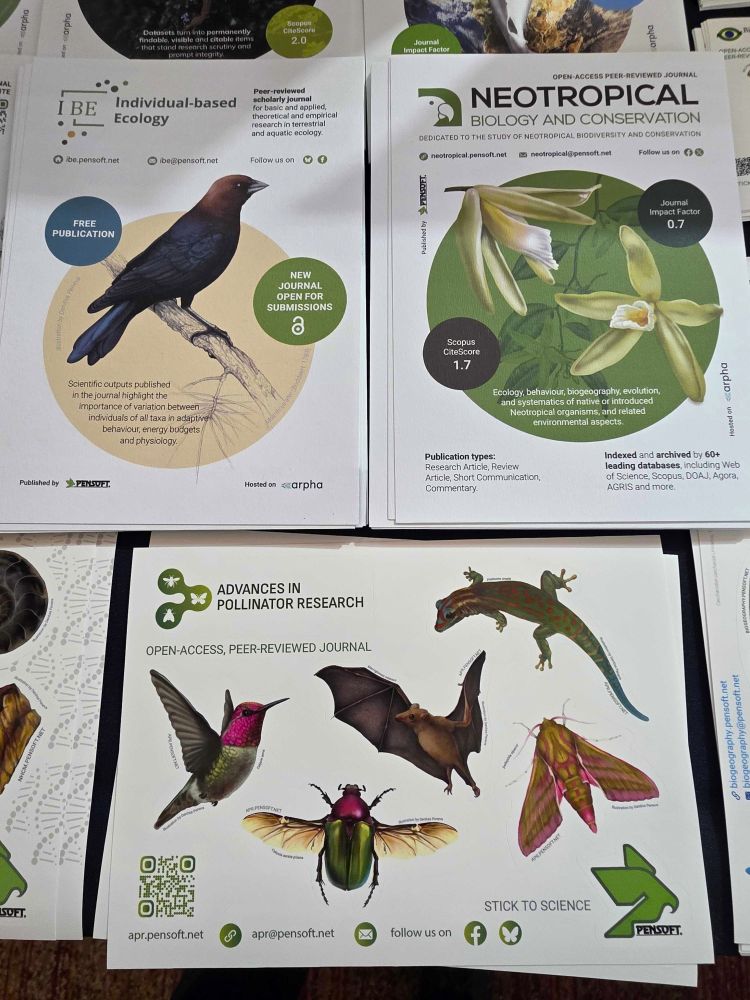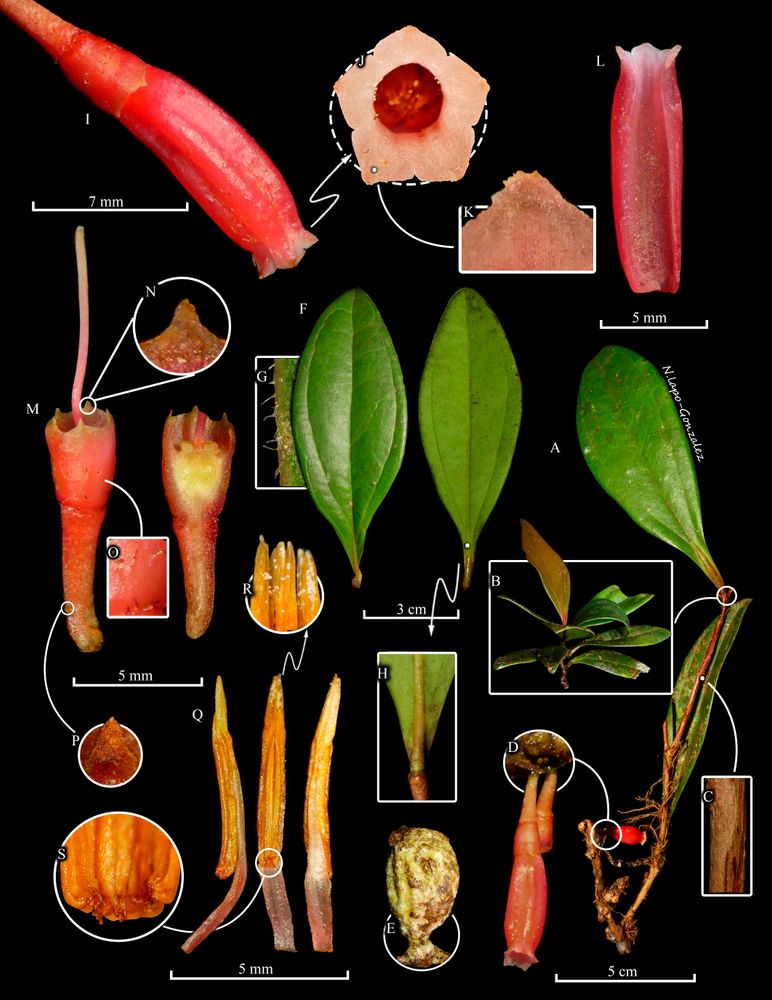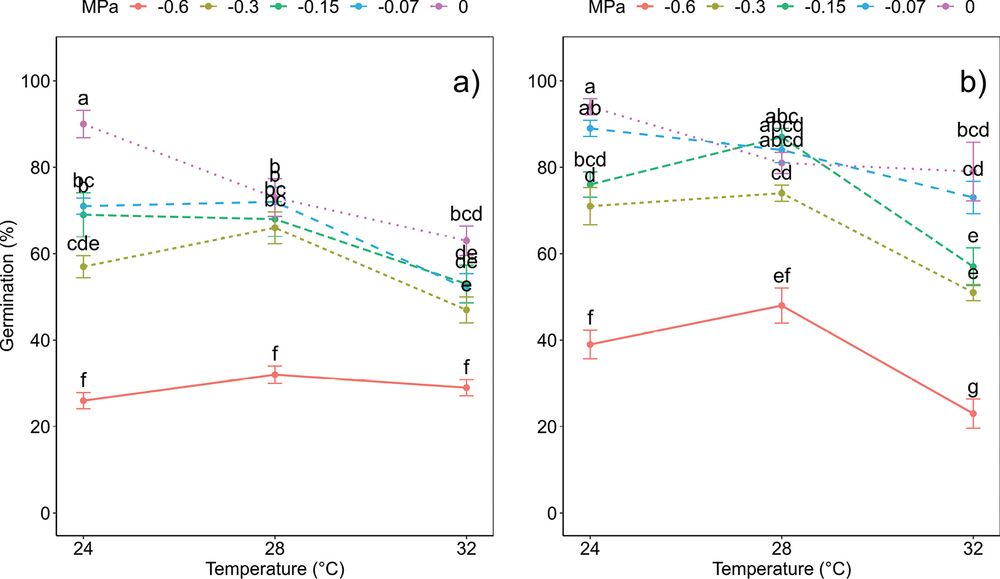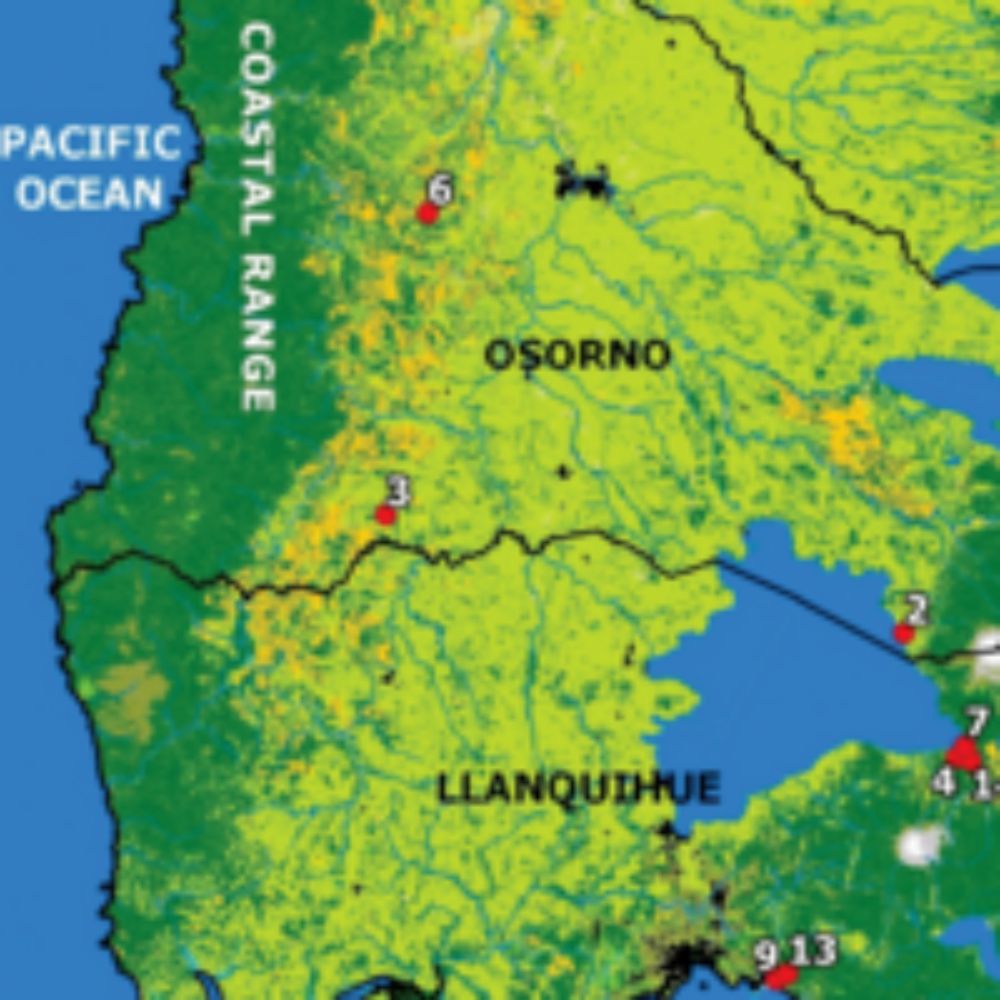
Neotropical Biology and Conservation
@neotropical.pensoft.net
Peer-reviewed, open-access journal devoted to the description, analysis and conservation of biodiversity.
Published by @pensoft.net. Powered by ARPHA.
Website: neotropical.pensoft.net
Published by @pensoft.net. Powered by ARPHA.
Website: neotropical.pensoft.net
Reposted by Neotropical Biology and Conservation
We had a fantastic time at the #IUCNCongress in Abu Dhabi! Read all about the event and Pensoft's involvement in our latest blog post: blog.pensoft.net/2025/11/04/p...

Pensoft showcases open science and restoration innovation at the IUCN World Conservation Congress
Pensoft joined thousands of global conservationists, policymakers, and researchers in Abu Dhabi for the IUCN World Conservation Congress 2025.
blog.pensoft.net
November 4, 2025 at 1:33 PM
We had a fantastic time at the #IUCNCongress in Abu Dhabi! Read all about the event and Pensoft's involvement in our latest blog post: blog.pensoft.net/2025/11/04/p...
We're happy to attend #LivingData2025 together with the @pensoft.net team! It's a great way to connect with researchers from all around the world and discuss open access publishing.




October 24, 2025 at 10:04 AM
We're happy to attend #LivingData2025 together with the @pensoft.net team! It's a great way to connect with researchers from all around the world and discuss open access publishing.
Reposted by Neotropical Biology and Conservation
These great scientific illustrations by @illustrixxxy.bsky.social showcase our equally great journals, including @neotropical.pensoft.net, @mycokeys.pensoft.net, @imafungus.pensoft.net, @saddi.pensoft.net, and @mbmg.pensoft.net at #LivingData2025 - truly works of art!


October 21, 2025 at 2:55 PM
These great scientific illustrations by @illustrixxxy.bsky.social showcase our equally great journals, including @neotropical.pensoft.net, @mycokeys.pensoft.net, @imafungus.pensoft.net, @saddi.pensoft.net, and @mbmg.pensoft.net at #LivingData2025 - truly works of art!
Two new species of the wasp genus 𝑆𝑐𝑜𝑙𝑖𝑎 are described from Mexico and Panama.
🔗 doi.org/10.3897/neot...
🔗 doi.org/10.3897/neot...


October 20, 2025 at 7:19 AM
Two new species of the wasp genus 𝑆𝑐𝑜𝑙𝑖𝑎 are described from Mexico and Panama.
🔗 doi.org/10.3897/neot...
🔗 doi.org/10.3897/neot...
What an incredible event! Our publisher, @pensoft.net, represented 𝑁𝑒𝑜𝑡𝑟𝑜𝑝𝑖𝑐𝑎𝑙 𝐵𝑖𝑜𝑙𝑜𝑔𝑦 𝑎𝑛𝑑 𝐶𝑜𝑛𝑠𝑒𝑟𝑣𝑎𝑡𝑖𝑜𝑛 and many other open-access journals at the #IUCNcongress in Abu Dhabi.
🎉Happy World Migratory #Birds Day! 🐦
🤩 Shoutout to everyone attending the #IUCNcongress today in Abu Dhabi: come by our stand #229 to find out what we've prepped for the celebration! 🎉
#WorldMigratoryBirdsDay #BirdLife
🤩 Shoutout to everyone attending the #IUCNcongress today in Abu Dhabi: come by our stand #229 to find out what we've prepped for the celebration! 🎉
#WorldMigratoryBirdsDay #BirdLife

October 14, 2025 at 10:06 AM
What an incredible event! Our publisher, @pensoft.net, represented 𝑁𝑒𝑜𝑡𝑟𝑜𝑝𝑖𝑐𝑎𝑙 𝐵𝑖𝑜𝑙𝑜𝑔𝑦 𝑎𝑛𝑑 𝐶𝑜𝑛𝑠𝑒𝑟𝑣𝑎𝑡𝑖𝑜𝑛 and many other open-access journals at the #IUCNcongress in Abu Dhabi.
Camera traps show seven arboreal mammal species actively using artificial canopy walkways in an unfragmented Amazon forest, providing key insights for tropical conservation corridor design.
🔗 doi.org/10.3897/neot...
🔗 doi.org/10.3897/neot...

Arboreal mammal use of canopy walkway bridges in an Amazonian forest with continuous canopy cover
The Amazon Basin is a biodiversity hotspot, with vertically stratified forests fostering complex habitats and high mammal diversity. Although mammals play a critical role in maintaining ecosystem stru...
doi.org
October 1, 2025 at 8:18 AM
Camera traps show seven arboreal mammal species actively using artificial canopy walkways in an unfragmented Amazon forest, providing key insights for tropical conservation corridor design.
🔗 doi.org/10.3897/neot...
🔗 doi.org/10.3897/neot...
Reposted by Neotropical Biology and Conservation
Easy prey: Opportunistic predation of great fruit-eating bat (Artibeus lituratus) by ocelot (Leopardus pardalis) with ocular anomaly in Cerros de Amotape National Park, Tumbes.
🔗 doi.org/10.3897/arph...
@neotropical.pensoft.net
🔗 doi.org/10.3897/arph...
@neotropical.pensoft.net

September 29, 2025 at 6:48 AM
Easy prey: Opportunistic predation of great fruit-eating bat (Artibeus lituratus) by ocelot (Leopardus pardalis) with ocular anomaly in Cerros de Amotape National Park, Tumbes.
🔗 doi.org/10.3897/arph...
@neotropical.pensoft.net
🔗 doi.org/10.3897/arph...
@neotropical.pensoft.net
Non-native species are widespread across inselbergs in Brazilian tropical forests, with many of them invasive, highlighting an urgent need for intervention.
🔗 doi.org/10.3897/neot...
🔗 doi.org/10.3897/neot...

September 10, 2025 at 6:12 AM
Non-native species are widespread across inselbergs in Brazilian tropical forests, with many of them invasive, highlighting an urgent need for intervention.
🔗 doi.org/10.3897/neot...
🔗 doi.org/10.3897/neot...
Two records of the giant planarian species 𝑃𝑜𝑙𝑦𝑐𝑙𝑎𝑑𝑢𝑠 𝑔𝑎𝑦𝑖 preying on the invasive slug 𝐿𝑖𝑚𝑎𝑥 𝑚𝑎𝑥𝑖𝑚𝑢𝑠 in Chile's temperate forests reveal two distinct types of predatory behaviour and elicit ecological considerations.
🔗 doi.org/10.3897/neot...
🔗 doi.org/10.3897/neot...

August 29, 2025 at 12:06 PM
Two records of the giant planarian species 𝑃𝑜𝑙𝑦𝑐𝑙𝑎𝑑𝑢𝑠 𝑔𝑎𝑦𝑖 preying on the invasive slug 𝐿𝑖𝑚𝑎𝑥 𝑚𝑎𝑥𝑖𝑚𝑢𝑠 in Chile's temperate forests reveal two distinct types of predatory behaviour and elicit ecological considerations.
🔗 doi.org/10.3897/neot...
🔗 doi.org/10.3897/neot...
Researchers explore how termites and ants share nests, looking at patterns of termite–ant cohabitation networks across different forest coverages in the Colombian Amazon, with a focus on taxonomic composition, nesting substrates, and ant functional guilds.
🔗 doi.org/10.3897/neot...
🔗 doi.org/10.3897/neot...

Cohabitation networks: exploring how termites and ants share nests in Amazonian forests
Cohabitation between ants and termites is a widespread yet understudied ecological interaction in tropical forests. This study explores the patterns of termite–ant cohabitation networks across differe...
doi.org
August 29, 2025 at 6:13 AM
Researchers explore how termites and ants share nests, looking at patterns of termite–ant cohabitation networks across different forest coverages in the Colombian Amazon, with a focus on taxonomic composition, nesting substrates, and ant functional guilds.
🔗 doi.org/10.3897/neot...
🔗 doi.org/10.3897/neot...
Researchers investigate the prevalence and parasitemia levels of avian malaria in a tropical dry forest region in eastern Guatemala, finding no significant differences between urban and rural bird populations.
🔗 doi.org/10.3897/neot...
🔗 doi.org/10.3897/neot...

August 26, 2025 at 7:09 AM
Researchers investigate the prevalence and parasitemia levels of avian malaria in a tropical dry forest region in eastern Guatemala, finding no significant differences between urban and rural bird populations.
🔗 doi.org/10.3897/neot...
🔗 doi.org/10.3897/neot...
Reposted by Neotropical Biology and Conservation
This adorable new species of velvet worm from Ecuador, however, was loved by all.
blog.pensoft.net/2024/06/27/c... 🧵(4/15)
blog.pensoft.net/2024/06/27/c... 🧵(4/15)

Cute but deadly: a new velvet worm species from Ecuador
The so-called "living fossil" shoots a sticky substance from a pair of glands to trap its prey.
blog.pensoft.net
August 8, 2025 at 10:05 AM
This adorable new species of velvet worm from Ecuador, however, was loved by all.
blog.pensoft.net/2024/06/27/c... 🧵(4/15)
blog.pensoft.net/2024/06/27/c... 🧵(4/15)
Reposted by Neotropical Biology and Conservation
During recent botanical explorations in thе Cordillera del Cóndor, researchers discovered a new species of 𝑇ℎ𝑖𝑏𝑎𝑢𝑑𝑖𝑎. Find out all about it here: doi.org/10.3897/BDJ....
#Neotropical #newspecies #rainforests @nybg.bsky.social
#Neotropical #newspecies #rainforests @nybg.bsky.social

August 8, 2025 at 8:57 AM
During recent botanical explorations in thе Cordillera del Cóndor, researchers discovered a new species of 𝑇ℎ𝑖𝑏𝑎𝑢𝑑𝑖𝑎. Find out all about it here: doi.org/10.3897/BDJ....
#Neotropical #newspecies #rainforests @nybg.bsky.social
#Neotropical #newspecies #rainforests @nybg.bsky.social
Researchers explore how high temperatures and drought affect the germination of two endangered Populus species from the Neotropical region of Mexico.
🔗 doi.org/10.3897/neot...
🔗 doi.org/10.3897/neot...

July 25, 2025 at 7:55 AM
Researchers explore how high temperatures and drought affect the germination of two endangered Populus species from the Neotropical region of Mexico.
🔗 doi.org/10.3897/neot...
🔗 doi.org/10.3897/neot...
Genetic diversity in pudu deer from southern Chile is negatively impacted by native forest fragmentation, highlighting the need to maintain forest continuity for the species' conservation and long-term survival.
🔗 doi.org/10.3897/neot...
🔗 doi.org/10.3897/neot...

Genetic structure and microsatellite-based genetic variation influenced by habitat fragmentation in pudu deer (Pudu puda) from southern Chile
Landscape alterations have strong impacts on the distribution of genetic variation within and between populations, and understanding these effects can provide insights for design conservation strategi...
doi.org
July 18, 2025 at 7:13 AM
Genetic diversity in pudu deer from southern Chile is negatively impacted by native forest fragmentation, highlighting the need to maintain forest continuity for the species' conservation and long-term survival.
🔗 doi.org/10.3897/neot...
🔗 doi.org/10.3897/neot...
Reposted by Neotropical Biology and Conservation
It's World Snake Day, which means its time to revisit this incredible video of two red-tailed coral snakes competing over a caecilian in the first documented case of kleptoparasitism (food theft) in wild elapid snakes! 🐍
July 16, 2025 at 12:20 PM
It's World Snake Day, which means its time to revisit this incredible video of two red-tailed coral snakes competing over a caecilian in the first documented case of kleptoparasitism (food theft) in wild elapid snakes! 🐍
We have moved from X to Bluesky! To keep up to date with the latest research from our journal, follow us here!

July 9, 2025 at 11:03 AM
We have moved from X to Bluesky! To keep up to date with the latest research from our journal, follow us here!

